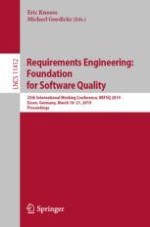
2019 | OriginalPaper | Buchkapitel
Decision Support for Security-Control Identification Using Machine Learning
verfasst von : Seifeddine Bettaieb, Seung Yeob Shin, Mehrdad Sabetzadeh, Lionel Briand, Grégory Nou, Michael Garceau
Erschienen in: Requirements Engineering: Foundation for Software Quality
Aktivieren Sie unsere intelligente Suche, um passende Fachinhalte oder Patente zu finden.
Wählen Sie Textabschnitte aus um mit Künstlicher Intelligenz passenden Patente zu finden. powered by
Markieren Sie Textabschnitte, um KI-gestützt weitere passende Inhalte zu finden. powered by